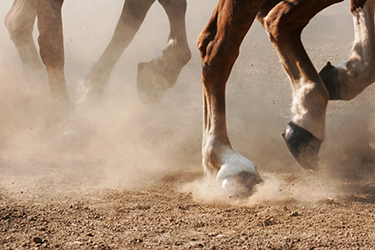Basic Tips: Helping Clients Combat Equine Lameness

It is not difficult to tell when a horse is suffering from lameness. Their gait is abnormal and they may be unwilling or unable to stand or move. Lameness is one of the most common causes for the loss of use in horses, but there are some steps that clients can take to help avoid this type of injury.
Ideal Weight
A horse that is overweight has an increased risk for lameness because the additional weight causes undue stress on their joints, tendons, ligaments and muscles. Clients can help to prevent lameness that arises from weight issues when they:
- Pay attention to the daily feed intake to avoid overfeeding.
- Determine the level of the horse’s energy needs; for example, is the horse idle or is it hardworking?
- Adjust the diet needs to meet the horse’s energy needs.
Ways clients can help their horse with weight reduction:
- Diet
- Reduce calories by gradually cutting the quantity of feed, not by cutting feed out altogether.
- Exercise
- Determine an appropriate method of exercise based on the condition of the horse
- Older, idle or obese animals will need to be slowly introduced to exercise.
- Design an exercise regimen that is consistent and includes:
- A length of time and level of intensity that advances as the animal’s fitness level improves.
- Follow a daily exercise plan.
Fitness
Clients should be aware of the steps to take that will help combat lameness and injuries when exercising their animal. For instance:
- Develop the habit of running your hands and fingers over the horse before and after exercise to detect any signs of heat, swelling or pain which could signal the presence of an injury that could worsen with inappropriate exercise.
- Always prepare the animal for its work by completing warm-up exercises first.
- Try to vary the type of exercise the horse is exposed to, which permits working with various muscle groups.
- Gradually increase the type and the level of exercise by planning a training program that allows for appropriate strengthening of bones and muscles.
- Complete the workout with a cool-down exercise period.
The Feet
Most causes of lameness are found in the foot, so it is imperative that clients know to frequently clean hooves and check for:
- Lodged foreign objects that can pierce the sole
- Wounds
- Infections
- Abscesses
- Bruising
Hooves should be watched for trimming and shoeing needs. It is important that clients keep in mind that:
- Individual horses have different hoof growth rates.
- Hooves typically grow faster in the summer and slower in the winter.
- Horses should be frequently observed for any signs of pain while walking and standing.
- Shoes should be checked to make sure they are properly fitted with no loose nails.
- Scheduled appointments should be established with the farrier that set appropriately timed intervals between trimmings.
Clients who choose to trim their horse’s hooves themselves should receive instruction to ensure that they:
- Take note of the natural line of the foot to avoid causing abnormal stress on the support ligaments.
- Trim and rasp the surfaces evenly so the foot remains level.
- Be careful not to over trim the heel.
- Watch to prevent the toe from getting too long.
- Avoid foot imbalance.
Physical Maturity
Clients need to be aware that the bones of a young horse continue to grow and ossify for several years after the period when a horse physically looks mature. One factor that can predispose a horse to lameness occurs when developmentally inappropriate training is started before the animal is physically ready. Clients should be advised to consult with their veterinarian about the physical maturity of their animal in order to determine an exercise program that is developmentally appropriate.
The best tip that a client can follow in order to help combat lameness is to routinely observe their horse for behavioral changes that could indicate an injury. The longer lameness goes unnoticed and untreated, the stronger the chances are that the animal will suffer serious and long-term damage.


Working Here
Our team members are encouraged to be the best they can be... at Covetrus we believe we impact one another.
Learn MoreNews & Events
FDA Cautions Pet Owners Not to Feed Texas Tripe Inc. Raw Pet Food Due to Salmonella, Listeria Monocytogenes
The U.S. Food and Drug Administration is cautioning pet owners not to feed their pets any of the Texas Tripe brand raw frozen pet food listed below because several samples of Texas Tripe raw pet food have tested positive for Salmonella and/or L. mono.
Careers
Are you looking for a place to let your talents shine? At Covetrus, we help our practitioner customers better serve their patients and take pride in providing the best customer experience possible. Search our open positions to see our available opportunities.
Newsletter
Stay current with what’s going on with Covetrus, subscribe to receive our newsletter and email communications. Subscribers will receive the latest information in practice management, sales and marketing, animal health, and more.



-3-(1).png?sfvrsn=2d806d73_0)

Leave a comment